If you’re a beginner interested in meditation but unsure how to get started, you’re not alone. Many people find themselves in the same boat. The good news is, meditation isn’t as complicated as it may seem. It’s a practice that anyone can easily incorporate into their daily routine. By calming the mind, meditation can help reduce stress and promote personal growth. In this article, we’ll delve into the basics of meditation and offer effective approaches tailored for beginners.
Understanding the benefits of meditation and discovering the method that works best for you is crucial. As you read through this guide, consider how you can weave meditation into your everyday life. You’ll likely find yourself experiencing greater peace of mind and enhanced focus.
- Learn the fundamental benefits of meditation, along with proper posture and breathing techniques.
- Discover mindfulness meditation—a perfect fit for beginners.
- Get tips on how to incorporate meditation into your daily routine.
Understanding the Basics of Meditation
Before diving into meditation, it’s important to grasp its benefits and fundamental techniques. Meditation is a fantastic way to calm the mind and reduce stress. Additionally, it helps you reflect deeply on yourself, allowing you to organize your emotions and thoughts. In this section, we’ll explore the various benefits of meditation, along with essential postures and breathing techniques. With the right knowledge, you can practice meditation more effectively.
What Are the Benefits of Meditation?
Meditation is known for its many positive effects on both the mind and body. To start with, it helps alleviate stress and promotes a state of relaxation. It also enhances concentration and contributes to emotional stability. These benefits can significantly improve the quality of your daily life. By continuing to meditate, you can gain a deeper understanding of yourself and foster personal growth.
- Meditation is effective for stress relief
- It helps improve concentration
- It deepens self-understanding and stabilizes emotions
Basic Posture and Breathing Techniques for Meditation
The posture you adopt while meditating is crucial. It’s essential to sit upright while maintaining a relaxed position. You can choose to sit on a chair or on the floor, but what matters most is that your body feels stable and comfortable. Breathing techniques are also key. Focus on natural breathing—slowly and deeply inhaling and exhaling. This simple act is vital for enhancing the effects of your meditation practice.
If you’re interested in this topic, check out our article on “Easy Meditation Tips for Beginners.” It’s perfect for those who want to start meditating but feel it might be too difficult. The article offers simple steps to kick off your meditation journey and tips for integrating it into your daily life. By following this guide, you’ll find it easier to incorporate meditation into your routine.
- Maintain an upright and relaxed posture
- Focus on deep, natural breathing
- A stable posture enhances the effects of meditation
Recommended Meditation Techniques for Beginners
If you’re just starting with meditation, you might be unsure about which method to try first. Fortunately, two of the best options for beginners are “mindfulness meditation” and “guided meditation.” These techniques are not only simple but also allow you to easily experience their benefits, making them perfect for establishing a meditation habit. In this section, we’ll dive deeper into these meditation methods.
How to Start Mindfulness Meditation
Mindfulness meditation focuses on bringing your awareness to the present moment. To get started, find a quiet place and take a comfortable seated position. Close your eyes and begin by directing your attention to your breath. By tuning into the sensations of your breathing, you’ll notice your mind starting to calm down. When thoughts arise, the key is not to get caught up in them but to gently bring your focus back to your breath. Gradually extending the time you spend in meditation will help you develop mindfulness.
- Find a quiet spot and settle into a comfortable position.
- Concentrating on your breath is essential.
- Practice returning to your breath without getting caught up in your thoughts.
Utilizing Guided Meditation
Guided meditation involves following audio instructions or an app to help you through the process. This method is particularly accessible for beginners, allowing you to meditate while feeling relaxed. Many apps offer a variety of meditations based on different themes, enabling you to choose one that resonates with your mood or goals. This flexibility makes it easier to maintain a consistent meditation practice.
If you found this article interesting, we have something special for you. Check out our detailed guide on “how to incorporate guided meditation into your daily routine,” which is especially beginner-friendly. This article covers everything from the basics of guided meditation to tips for making it a habit, helping to expand your meditation experience. You can read it here: 初心者にも安心!毎日の習慣にできる誘導瞑想の始め方.
- Meditate by following audio guidance.
- Choose themes that align with your personal goals.
- The ability to relax and practice without pressure is a major advantage.
Tips for Enhancing the Benefits of Meditation
When practicing meditation, it’s not just about going through the motions; it’s important to find ways to maximize its benefits. To make meditation a regular part of your life and to practice it effectively, there are several tips and environmental factors to consider. In this section, we’ll explore how to integrate meditation into your daily routine and create the ideal setting for it.
Tips for Building a Habit
To make meditation a habit, it’s effective to practice at the same time every day. Incorporating it into your daily routine—like right after you wake up or just before going to bed—can make the process feel more natural. Starting with shorter sessions and gradually increasing the time is also a great approach. Even amidst busy days, dedicating just 5 or 10 minutes to meditation can help establish this practice as part of your routine.
- Consistency is key: meditate at the same time each day
- Begin with short sessions and gradually extend them
- Integrate it into your daily routine for a smoother continuation
The Importance of Setting the Right Environment
The environment in which you meditate can significantly impact its effectiveness. Choosing a quiet and calming space makes it easier to relax your mind. Additionally, paying attention to lighting and scents can help create a more pleasant atmosphere. By setting up a space where you can unwind, you can achieve a deeper meditation experience.
- Selecting a quiet, calming space is essential
- Use lighting and scents to create a comfortable atmosphere
- A well-prepared environment leads to a more profound meditation experience
Integrating Meditation into Daily Life
Meditation can significantly enhance your daily life when you incorporate it into your routine. By learning techniques that help alleviate stress and foster personal growth, you can enrich your everyday experiences. This section delves into how to use meditation to reduce stress and ways to cultivate personal development through meditation.
Effective Meditation Techniques for Stress Relief
One of the most effective meditation techniques to relieve everyday stress is a brief session lasting just a few minutes. Especially during breaks from work or study, these short meditative moments can reset your mood and help you refocus. By directing your attention to your breath and calming your mind, you’ll likely feel the stress begin to melt away. So, the next time you’re feeling overwhelmed, try integrating meditation into your routine.
- Incorporating short meditations into your daily life is beneficial.
- It’s particularly effective during breaks from work or studying.
- Focusing on your breath can help alleviate stress.
Harnessing Meditation for Personal Growth
Meditation is also a powerful tool for fostering personal growth. Taking time to connect with yourself allows you to experience inner development. Specifically, engaging in meditation focused on self-reflection and goal-setting can clarify what you truly desire and motivate you to take action. By regularly practicing meditation with personal growth in mind, you can lead a more fulfilling life.
- Making time to connect with yourself is essential.
- Engage in meditation that supports goal-setting.
- Regular practice encourages inner growth.
Conclusion
Meditation is a simple yet powerful mental exercise that anyone can start, even if you’re a beginner. By understanding the fundamentals of meditation and practicing effective techniques, you can reduce stress and foster personal growth. Incorporating meditation into your daily routine can help you maintain a sense of calm and lead a more fulfilling life. With a little creativity in establishing habits and creating the right environment, you can enhance the benefits of meditation even further.
Take some time to integrate meditation into your life and enjoy a refreshing break for your mind. We’d love to hear about your experiences and thoughts in the comments!
- Meditation is easy to start for beginners
- It’s effective for stress reduction and personal growth
- Establishing a habit and creating the right environment is key



Comment